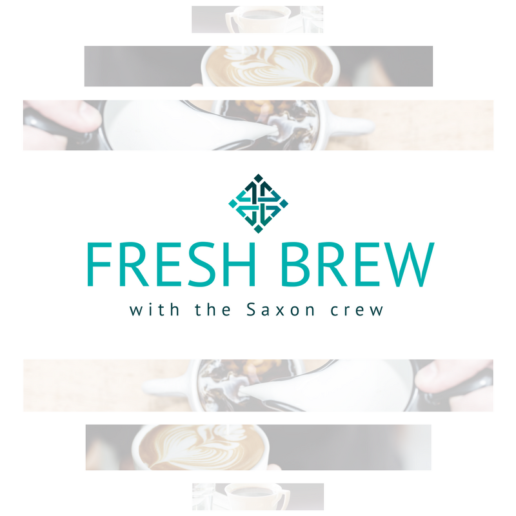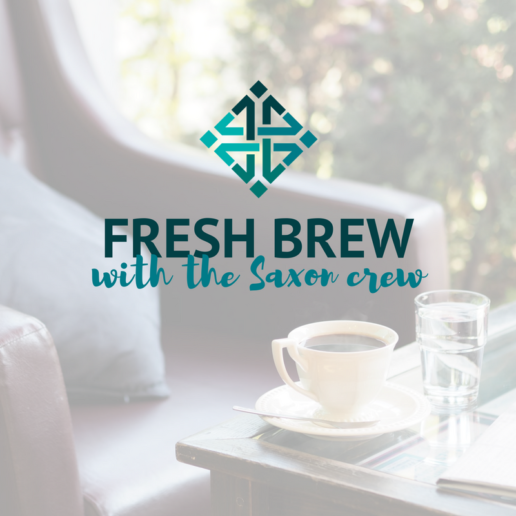Fresh Brew with Alesha Mack
Welcome to our brand new segment, Fresh Brew, where we will be exploring the delicious coffees, teas, and snacks of some of our employees! You can look forward to our Fresh Brew blog post on the first Friday of every month.
“The first piece of advice I would give is to be patient because some people are unsure of what exactly they are asking. Also, remain calm and attentive. Lastly, SMILE!”
Alesha Mack is a Client Service Manager and oversees the Client Service Team at Saxon Financial Services.
Alesha has three children who are the light of her world. In her free time, she enjoys exploring new activities with them and one day plans to travel the world together.


Caramel Macchiato from Starbucks
“I love this coffee because it is sweet but has a nice kick to it to help me get through my mornings!”

Coffee Cake from Wyoming Pastry Shop
Alesha loves snacking on a coffee cake from Wyoming Pastry Shop. View their website here.
Fresh Brew with Dave Smetana
Welcome to our monthly segment, Fresh Brew, where we will be exploring the delicious coffees, teas, and snacks of some of our employees! You can look forward to our Fresh Brew blog post on the first Friday of every month.
“There has to come a point where the research stops, and the decision gets made! It is too easy sometimes to stay in the ‘searching out all possibilities mode’ out of fear of making the ‘wrong decision.'”
Dave Smetana is the CFO at Saxon Financial Services.
Dave and his wife, Terry have 2 children, whom they vacation with whenever possible to places they have never been. A recent trip was out West to see the Grand Canyon, Hoover Dam, and other amazing sites. For an upcoming trip, Dave will travel to Colorado.


Caffe Verona Dark Roast or Whole Bean Dark Roast
Dave enjoys sipping on a Starbucks Caffe Verona Dark Roast while at work or any Costco whole bean dark roast when he’s at home.

Banana Nut Muffins
Dave’s favorite mid-morning snack to enjoy with a freshly brewed cup of coffee is a Paleo Banana Nut Muffin recipe he got from fellow employee, Amy.
What Happened to Employee Retirement Plan Education?
As an employer, you are the universal platform for your employees’ benefits and retirement knowledge. Every day, you must communicate and educate your employees on the benefits you offer. Whether that is through verbal communication, an office chatroom, or a simple email, you should act as a bridge between the gap that is, “What do I get for working here? How am I protected? How can I contribute to my savings?”

There is no doubt how much pressure this puts on your shoulders. When it comes to educating your employees about their 401(k) Plan, it is inevitable that you may feel lost. You don’t have anyone to advise you on the topic (except Google, of course); you have no proper guide for navigating the benefits and retirement landscape. How can you provide the best resources and tools to your employees, if you don’t have access to them to begin with?
In this month’s installment of CenterStage, we spoke with Todd Yawit, Director of Employer-Sponsored Retirement Plans at Saxon Financial Services, hoping to scope helpful advice for employers struggling with benefits and retirement education. The conversation led to a prime focus on the power of 401(k) Plans, and employees’ extreme lack of knowledge about them, and ended with this simple fact:
Providing access to A to Z retirement services for your employees is not something you should skip on; and could lead to lower health insurance premiums in the long-run.
“Too many Americans are getting to their retirement age with no funds or no ability to provide the extra income they’re going to need over and above Social Security,” Todd said. “There needs to be a mechanism or tool available for people to save money, preferably tax-favored treatment of that money.”
That tool is a 401(k) Plan. Providing 401(k) Plan education in the workplace is an easy way for employers to show they care about their employees’ futures. It gives employees opportunities to save for their retirement, ultimately bettering themselves and their loved ones in the long run.
Getting Familiar With 401(k)s
People by nature tend to stick to the rule, “Out of sight, out of mind,” and 401(k) Plans are the epitome of that rule. However, this is the wrong path to take. 401(k) Plans can be a great tool for employers to leverage.
“At Saxon, we highly suggest employers look at advanced plan designs, instead of just a basic 401(k) Plan,” said Todd. These plan designs can lead to better retirement-readiness of plan participants, which will better prepare them for retirement, and can potentially lower health insurance premiums for the business in the long-run. Todd continued, “Advanced plan designs may also increase business tax deductions; provide better benefits for business owners and key employees; and eliminate most discrimination tests.
Automatic Enrollment
Once an employee becomes eligible for a 401(k) Plan, they are automatically enrolled in one. This tool helps increase enrollment in the Plan, because studies have shown few employees “opt-out” once they are automatically enrolled.
There has been a push for employers to add Automatic Enrollment to their 401(k) Plans. Participation has been at an all-time low, meaning more and more employees are getting to retirement with nothing to rely on except their Social Security. Automatic enrollment, and employee education can be great tools to help employees reach their retirement-readiness.
Automatic Increases in 401(k) Contributions
When employees do get involved with their 401(k) Plans, it’s usually with the initial set up, then it’s often forgotten about. Knowing how crucial those savings are for employees’ future livelihoods, there has been a push for automatic increases in annual 401(k) contributions.
“Ongoing education will help employees understand how small increases in their retirement savings, especially when they get a raise, will have a big impact on their ability to retire at a reasonable age”, Todd explained.
Saxon Financial Advisors
Saxon Financial Services offers A to Z retirement plan services for Simple IRAs, Safe Harbor 401(k) Plans, 401(k) Plans, 403(b) Plans, and Cash Balance Pension Plans. Saxon can act as a 3(38) Investment Manager, which can reduce the employer’s fiduciary liability with respect to investment selection, monitoring, and replacement. We can create and manage custom asset allocation models for participants in this role as well. “This allows employees to focus on what really matters, saving for retirement and not worrying about picking and managing their investments”, Todd concluded.
If you currently struggle with the education and support of your 401(k) Plan, then call 513.573.0129 or email Todd at tyawit@gosaxon.com.
U.S. Department of Labor's New Compliance Assistance Tool
On February 6, 2019, the U.S. Department of Labor announced the launch of the electronic version of their Compliance Assistance Tool (Handy Reference Guide to the Fair Labor Standards Act (FLSA)). This new version will assist employers by providing them with basic Wage and Hour Division (WHD) information, as well as links to other resources.
This electronic resource was created as a part of the WHD's efforts to modernize compliance assistance tools, as well as provide easy-to-use, accessible compliance information. In coexistence with worker.gov, employer.gov, and other online tools, this tool will help improve employer understanding of federal labor laws and regulations.
View the digital Compliance Assistance Tool here.
Read the DOL's full press release here.
SOURCE: U.S. Department of Labor (6 February 2019) "U.S. Department of Labor Announces New Compliance Assistance Tool" (Web Press Release). Retrieved from https://www.dol.gov/newsroom/releases/whd/whd20190206-0
Fresh Brew with Kelley Bell
Welcome to Fresh Brew, where we will be exploring the delicious coffees, teas, and snacks of some of our employees! You can look forward to our Fresh Brew blog post on the first Friday of every month.
“Wellness…health insurance costs less for healthy people so, be a person of excellence which is a person that cares what they put into their body.”
Kelley Bell is a Group Health Benefits Consultant at Saxon. Kelley has over 25 years of experience in the financial industry. Kelley enjoys partnering with business owners and those responsible for choosing benefits for their employees. She understands that every business is unique and is dedicated, accessible and proactive in serving the needs of each client.
When not working, Kelley enjoys watching her son play college baseball. He is a sophomore at Old Dominion University in Norfolk, Virginia on a baseball and academic scholarship.

Water
Kelley favorite brew is water!

Fruits and Veggies
Kelley’s favorite snacks are fruits and veggies.
5 great, underutilized places to promote your recruitment content
Are you promoting your recruitment content? Read this blog post to learn about 5 underutilized places you can promote your recruitment materials.
All your time and effort invested in brainstorming great recruitment content ideas and creating interesting and useful recruitment content for every step of a candidate's journey will be wasted if you don’t promote it.
Many HR professionals publish their recruitment content on their company’s career sites and job posting sites.
They also share it on social media. They know that if they want to be successful at promoting their employer's brand on social media, they have to learn all the tricks of recruiting on Facebook and create an outstanding LinkedIn Company Page.
However, there are many other places where you can promote your recruitment content to maximize its reach and achieve better ROI.
5 great, underutilized places to promote your recruitment content
Here is the list of the 5 best underutilized places where you can promote your recruitment content for free:
1. Your employees’ social media profiles
Asking your employees to share your recruitment content on their personal social media profiles is one of the most effective tactics for promoting your recruitment content. Recruitment content shared by employees receives 8 times more engagement than content shared by companies.
2. Online forums
Online forums are very effective, but often overlooked place to promote your recruitment content on. You can choose between numerous different forums, from general ones to those dedicated to special industry areas or any other topics.
3. Blogs
Blogs are another relatively underutilized place where companies can promote their recruitment content. Do a little research to find out which blogs your candidate persona regularly follow and offer to write a guest blog post.
4. University websites
If you’re looking to attract top young talent, then university websites are your go-to places for promoting your recruitment content. Many universities and colleges offer an opportunity for employers to advertise their recruitment content completely free of charge.
5. Company review sites
Online company review sites (such as Glassdoor and Great place to work) are a perfect place to promote your recruitment content and enhance your employer brand. According to Glassdoor, 54% of online job seekers read company reviews from employees.
Martic, K. ( 30 July 2018) "5 great, underutilized places to promote your recruitment content" (Web Blog Post). Retrieved from https://hrtechweekly.com/2018/07/30/5-great-underutilized-places-to-promote-your-recruitment-content/
'Pawternity' leave acknowledges pet owners' needs
Studies show that pet-friendly policies are trending. Are you considering implementing pet-friendly employer policies? In this article, Gurchiek lists questions employers should consider when creating pet-friendly policies.
When Anne Doussan adopted Celie, a Labrador retriever mixed breed in 2016, she had no idea her 8-week-old pup had three serious heart conditions and would require frequent trips to the veterinarian. Her boss at One-Sixteen, a real estate investment company in New Orleans, was understanding when Doussan needed to take paid time off (PTO) for Celie's appointments.
"They were incredibly understanding of my puppy's special needs," Doussan said, noting that she was allowed to report to work a few minutes later than scheduled or leave a few minutes early from her job as executive assistant. And with her supervisor's permission, she took extended lunch breaks to check on Celie. When Celie began having seizures, Doussan's boss let her bring Celie to work so Doussan could keep a careful eye on her. Her boss even let Celie take refuge under his own desk during rainstorms. When Celie's condition required her to stay home, Doussan was allowed to work remotely.
Doussan experienced the benefit—however informally—of "pawternity" leave. Pet-friendly employer policies are a trend, according to Steven Feldman, executive director at Human Animal Bond Research Institute (HABRI) in Washington, D.C. HABRI conducts research into the health benefits of having pets.
"Over the last five years we've seen this [trend] increase," Feldman said. "Millennials are getting pets as their 'starter kits.' A lot of Millennials, before they have children, often end up with feline or canine children as a way to start [parenting]."
In fact, Millennials are the primary pet-owning generation, slightly edging out Baby Boomers (35 percent and 32 percent, respectively), according to the American Pet Products Association.
"Those [pets] are just as much a part of their families as human kids will be later on. They're looking for … acknowledgement [from employers] of the important role of pets in their lives."
That acknowledgement can take different forms. Organizations that don't allow pets in the workplace may still offer pet-supportive benefits—pet health insurance, pet bereavement leave, time off to take a pet to the vet—that "signal you're looking at the employee's entire family," Feldman said. "These are all things that show you care."
That can translate into engagement and retention. Ninety percent of employees in pet-friendly workplaces feel highly connected to their company's mission, fully engaged in their work and willing to recommend their organization to others, according to a survey of 2,002 full-time workers in the U.S. HABRI and Nationwide, a health insurance provider headquartered in Columbus, Ohio, conducted the online survey in December.
Pets are considered part of the real estate team at AE Home Group in Baltimore, said Jeff Miller, who is a realtor for the company.
"Most of our real estate agents have dogs, and many of our clients are the direct result of time spent at the dog park," Miller said in an e-mail. "Whenever an agent gets a dog, it's like we're gaining a new team member. We'll lower that agent's client load for the month and encourage them to get involved with local dog-training groups and organizations. We find that this almost always pays off with even more clients and a larger network of homeowners and potential homeowners."
Questions to Consider
Marie Larsen, SHRM-CP, office manager and HR generalist at Searls Windows and Doors Inc. in Plainfield, Ill., said her employer does not offer pawternity or pet bereavement leave, but it would support an employee who wanted to use PTO for pet care or time to mourn.
"I've been that grieving employee and knew that I would be useless at work after putting our dog down last August. That's why we took her in on a Friday afternoon, I took the afternoon off, and my family and I had the weekend to be together and grieve. If a pet were to die suddenly, obviously the timing would be out of the employee's control," she said.
However, while Searls would allow an employee whose pet had died to take the day off unpaid if that employee had no PTO left to use, Larsen said she would struggle to recommend offering specific pet bereavement or other pet-related time off.
"Having specific days for pet care or pet grieving leaves a company wide open for problems. Having a general policy that allows employees with pets to utilize their standard PTO for furry family members might be a better overall approach," she said.
Creating a pet-friendly office takes some thought, Larsen noted. She suggested employers consider the following questions before venturing into pet-supportive benefits:
- "What constitutes a pet? A Dog? Cat? Lizard? Gerbil? Fish? Horse? Someone's pet is someone's pet, regardless of what type of critter it is. If one pet owner gets time off, ALL pet owners should get time off," Larsen said in a SHRM Connect discussion.
- "How much time would a company allow? One day per year? Two? One per pet? One day per pet might work if the employee lost one animal, but what do you do for someone who lost a tank full of fish? I had a friend who put one of her dogs down, then less than a month later had to put her other dog down. How much time off would she get? One day for each dog? More? Less?"
- "Bringing a new pet home, especially a very needy puppy or kitten, could take weeks for them to mature beyond the 'baby' stage. How much time would a policy allow for these situations? A couple of days? A couple of weeks?" she asked.
- "What do you do about employees with no pets? How do you provide similar benefits to prevent these employees from claiming discrimination?"
A specific pet policy makes sense, Larsen said, for businesses where pets are part of the culture, such as Rover.com, which provides dog-sitting services nationwide.
That's the case at Seattle-based Trupanion, which provides medical insurance for pets. The company offers its 500 employees three days of pet bereavement leave. It has had 250 dogs "and a few brave cats" in the workplace, according to Michael Nank, the company's public relations manager.
"Our pets are an important part of our culture, and they constantly remind us why we come to work—to help the pets we all love to receive the best veterinary care," Nank said in an e-mail. "When one of our employees loses a pet, we are acutely aware of the family-like bond that exists between them and their pet, and the need they may have to take the time to grieve and process the loss."
SOURCE:
Gurchiek, K (10 July 2018) "'Pawternity' Leave Acknowledges Pet Owners' Needs" [Web Blog Post]. Retrieved from https://www.shrm.org/resourcesandtools/hr-topics/benefits/pages/pawternity-leave-acknowledges-pet-owners-needs.aspx
Fresh Brew With Tabitha McIntosh
Welcome to our brand new segment, Fresh Brew, where we will be exploring the delicious coffees, teas, and snacks of some of our employees! You can look forward to our Fresh Brew blog post on the first Friday of every month.
“Each client is different!”
Tabitha enjoys helping customers and prides herself on the understanding of their needs and the discovery of knowledge along the way. She especially enjoys following through with the customer and learning new things that will help her excel in her career and better service future clients.

Favorite Brew
Pumpkin Spice Latte
“I love grabbing this from either Starbucks or Royce Cafe in Lebanon!”
Favorite Snack
…Nothing!
“I like my coffee on it’s own. There are plenty of calories in each cup!”
Fresh Brew: Brianna Matchett Loves Alreddy Cafe
Welcome to our brand new segment, Fresh Brew, where we will be exploring the delicious coffees, teas, and snacks of some of our employees! You can look forward to our Fresh Brew blog post on the first Friday of every month.
“Loving what you do everyday is key.”
Brianna Matchett loves working as the Marketing Coordinator at Saxon Financial Services.
She was born and raised here in Cincinnati, Ohio and loves the outdoors. When she’s not working, she enjoys exploring the city of Cincinnati and spending time with friends and family. Her favorite hobbies include staying in and watching movies with popcorn and taking on new challenges.

Favorite Brew
Chai Tea Latte
“I love grabbing my favorite brew from my local coffee shop, Alreddy Cafe.”
Favorite Snack
BLT
“Mmm…BLT with two eggs from Alreddy Cafe goes perfectly with my latte.”












